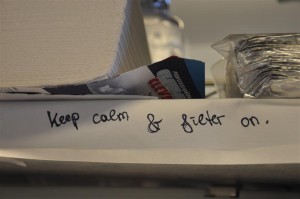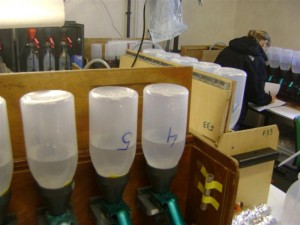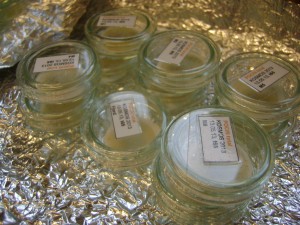Filtrations are fun. Well, for a short while, yes: filling up filtration bottles with a specific water volume (as large as possible to get sufficient particulate matter on your filter and as small as possible to stay in the recommended time limit of ca. 30 min per filtration, avoiding possible modifications of filtered particles), upending the open bottles fast on the filtration funnels without spilling any water and then watching the water being sucked away by a vacuum pump, resulting in a filter covered with the particulate matter that was bigger than the filter pore size.
If you do that process, which repeats itself according to the number of parameters to filter several times on a sampling day, for a longer time, it becomes less fun but more routine (with the exception of the “upending the open bottle on the funnel”-part, which is ALWAYS fun. I think.). Some people might even call it plain boring, yet, you could also see it as a kind of meditation, watching and waiting for air bubbles to rise and water levels to sink. Keep calm and filter on.

Times of slow running water (e.g. spring bloom) trained our patience. The only task in those moments might be to watch the water level in the bottles sink. Meditation for free. Pictures: Dana Hellemann, GEOMAR.

4 of 6 filtration racks, which were usually running at the same time. The regular check of the water level in all bottles turned easily into a run from rack to rack, leaving hardly time to feel bored.
For the last 5 months I filtered water for the parameters of particulate organic matter (POP, POC/PON, BSi) as well as for fatty acid analysis. And from time to time I got “a special task only YOU can do, Dana”- an additional filtration for scanning electron microscopy (SEM), which took HOURS, but how could I resist such a job offer?! Thanks to Saskia for helping me out!
In 54 sampling days (restart to t107) I filtered 4200 l water in total, which relates to the average water volume of 30 bath tubes. I produced about 5300 filter samples (POP: 1188, POC/N: 2376, BSi: 1023, fatty acids: 660, SEM: 40), consumed at least 4300 glass fibre and 1050 cellulose acetate filter, as well as 2400 glass petri dishes. Unfortunately, I also flooded three vacushieldsTM, sorry for that.
Some numbers are just reasonable estimated: Number of killed copepods and other zooplankton, being the unlucky ones to end up on my filter? Quite many. Working hours in front of the filtration rack? Quite a few. The number of working hours was luckily uncorrelated to these classic filtration faults*, every scientist is likely to experience at some point in his/her filtration career. Just once in five months I used the fastest possible filtration option (Nr.1) and filtered directly on the frit instead of going the conventional way of using a filter: “Uh wow, this one goes REALLY fast today!”
All in all: I had fun during all those hours I spent filtering. But I was also happy to turn off the last pump some days ago. Finally no pump noise anymore 🙂
*Classic filtration faults or 5 ways to mess up a filtration most efficiently, ranked from bad (5) to worst (1):
5. Drop the filter when ready.
→ Quite annoying as you were already on the finish line. Back to start and once again.
4. Use the wrong filter.
→ Quite annoying like Nr. 5, which can yet turn into REALLY annoying in case you might first notice your mistake when doing the according analysis…. Very popular: glass fiber filters for biogenic silicate (BSi) filtration. Assumed BSi absorption: 100%.
3. Filter on at least 400 mbar.
→ Speeds up your filtration. And increases the chance to destroy the cells on your filter. Your choice.
2. Use just half of the filter. And the frit for the other half.
→ Speeds up your filtration. And might question your scientific conscience: repeating the filtration or noting in the protocol, that you missed half of the sample?
1. Filter directly on the frit, don´t use any filter at all.
The fastest and most unsuccessful way of doing a filtration. An absolute classic.
By Dana Hellemann
